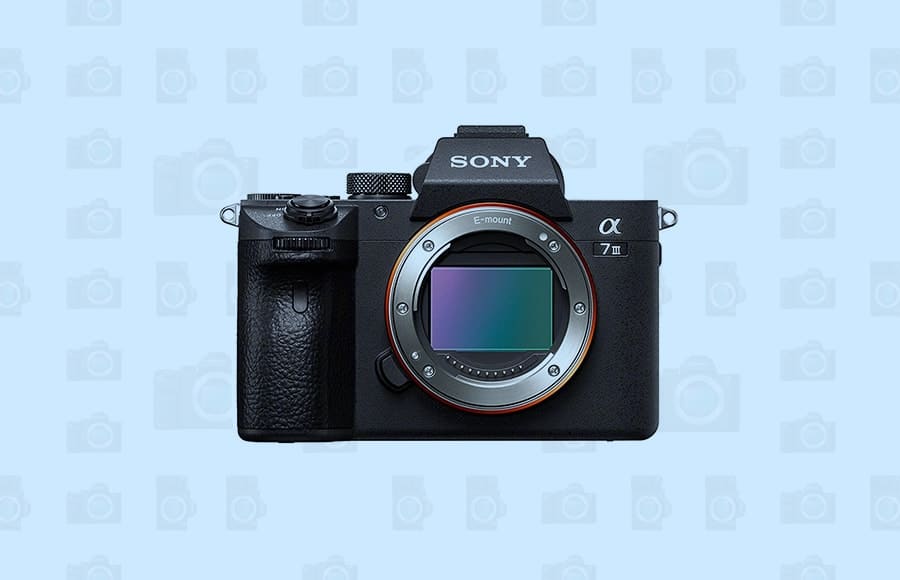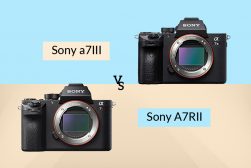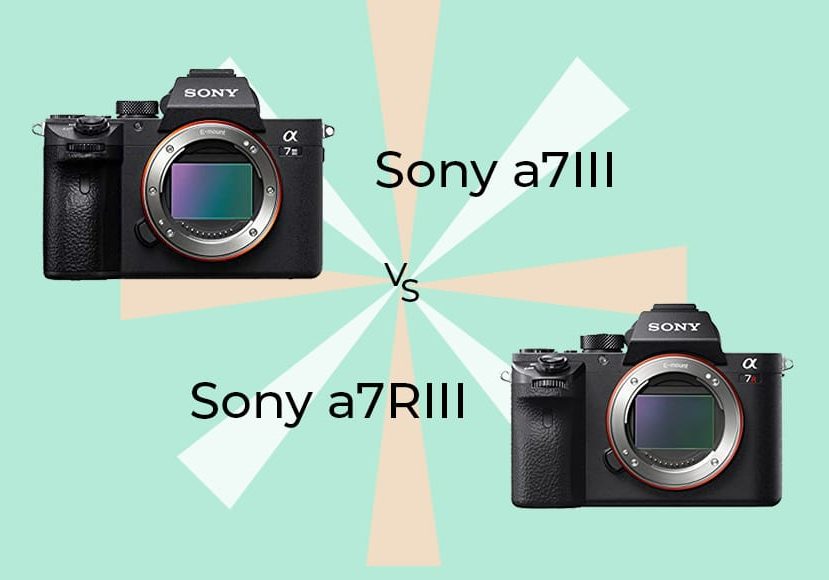
Sony a7 III vs a7R III
Choosing between the Sony a7 III vs Sony a7R III? This guide tells you everything you need to know! Find out differences, pros, cons & more.
This Sony a7 III vs a7R III guide is exactly what you need if you’re struggling to choose between these two cameras.
The Sony a7 III is one of Sony’s flagship mirrorless cameras, offering an incredible all-around package: lightning-fast autofocus, good full-frame resolution, 4K/30p video, dual card slots, and more.
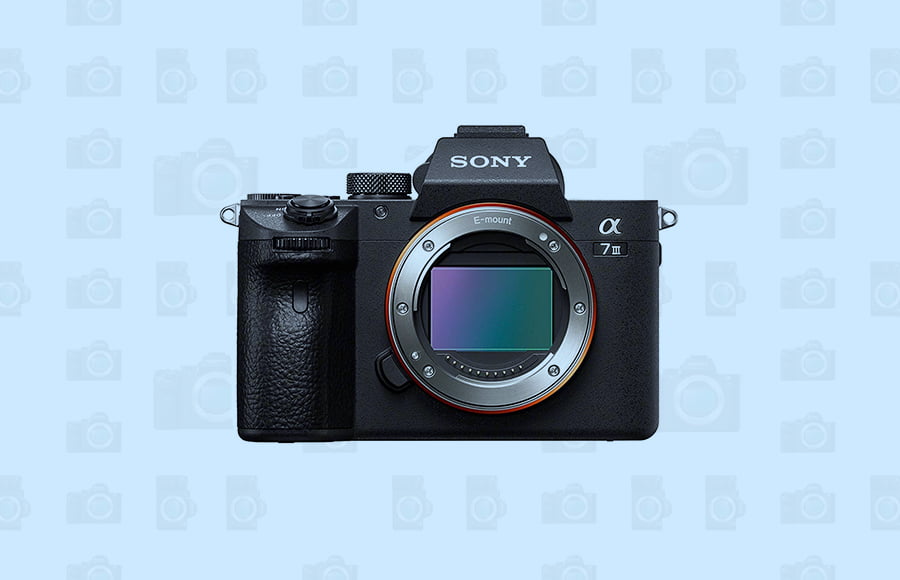
The a7 III boasts incredible autofocus, improved battery life, and a lower price tag.
But while the Sony a7 III is the newer, faster mirrorless snapper, the a7R III will impress a lot of photographers with its huge megapixel count – especially those looking to do commercial, landscape, or other high-resolution shooting.
So which option is best?
Read on to find out!
Sony a7 III vs Sony a7R III | Key Differences
1. Size & Weight
Looking at the Sony a7 III next to the Sony a7R III, you’ll be hard-pressed to notice any differences.
In fact, the bodies are essentially identical, sporting similar weights: 650 g (23 oz) on the Sony a7 III, versus 657 g (23.2 oz) on the Sony a7R III.
They also feature near-indistinguishable dimensions:
- 126.9 x 95.6 x 73.7 mm on the a7 III
- 127 x 96 x 74 mm on the a7R III
In other words, these two cameras are relatively compact and lightweight compared to full-frame DSLRs, but aren’t especially small compared to their mirrorless brethren.
That said, the form-factor is pretty nice. Either camera will allow you to shave off several hundred grams from your kit if you’re frequently hiking or traveling, and you won’t feel as uncomfortable carrying your camera around on street or casual outings.
The Sony Alpha cameras all have near-identical bodies (you’ll see the similarities in the a7R II vs a7R III too.)
2. Build & Handling
Given the basically identical camera bodies, you’re not going to notice much in terms of build and handling differences.
The a7 III and the a7R III are relatively compact cameras without being too small – so they feel nice in your hands and don’t start to get uncomfortable after a couple of hours of shooting.
The slimmer bodies compared to a DSLR are useful for traveling, hiking, and casual shooting, as mentioned in the previous section. But this does come with a slight handling drawback: The front grips, while decent, just don’t give you as much purchase as a DSLR grip.
So if you’re a person with bigger hands and a history of using big lenses, the body size of these cameras may take a bit of getting used to.
Fortunately, both the a7 III and the a7R III are built with professional photographers in mind. You get magnesium construction, weather sealing, and cameras you can count on.
That said, Sony has taken some flack for its inferior weather sealing compared to competitors. So in other words, proceed into difficult conditions with caution.
You also get around 5 stops of image stabilization on the a7R III and the a7 III, which is especially useful when shooting handheld in low light.
Oh, and did I mention the dual card slots on both cameras – which give professional photographers peace of mind in once-in-a-lifetime situations?
While I delve into electronic viewfinder features and LCD features in the next section, I’ll briefly note that both models do a good job here. You get nice EVFs, especially on the a7R III (which has the EVF resolution edge).
You also get touchscreen displays that tilt, though vloggers may be frustrated with the lack of a fully-articulating LCD on these two cameras.
3. Rear LCD & EVF
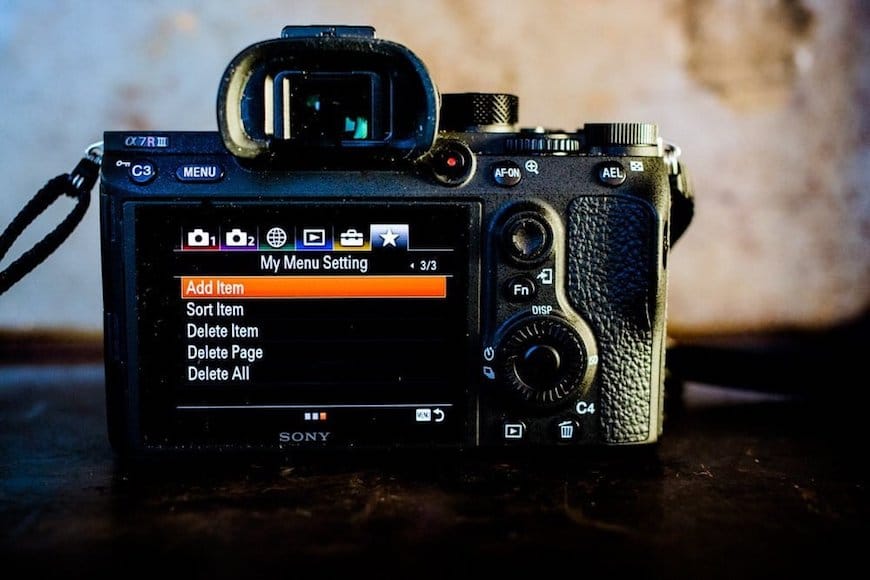
© The Starks
Here’s where we start getting into the meat of this camera comparison.
Because while the a7 III offers a perfectly adequate electronic viewfinder and display, it just can’t compete with the a7R III, which is stacked with higher-end features for a top-notch shooting experience.
Using the Sony a7 III, you’ll find the electronic viewfinder to be adequate. It sports a 2.36M dot, 0.78x OLED EVF, one that looks crisp and will serve you decently in the field.
But it feels a bit behind, especially when you consider the a7 III’s other top-of-the-line features.
You also get a 3”, tilting, 922K dot display, which includes touch functionality (a feature that’s becoming more important to a lot of photographers).
As I mentioned in the previous section, a fully-articulating screen in the style of the Canon EOS R would be nice, but isn’t necessary for most shooters – excluding vloggers, who may want to opt for a different line of cameras entirely.
The a7R III, on the other hand, offers a top-notch electronic viewfinder. It offers 3.686K dots, includes 0.78x magnification, and looks great. In good light, you may even forget you don’t have an optical viewfinder (though photographers looking for the absolute best-of-the-best EVF should take a look at the a7R IV).
The a7R III also features a 3” tilting display, though it has a slight resolution upgrade compared to the a7 III: 1.4M dots, for a crisper, clearer view.
As with the a7 III, the lack of a fully-articulating screen is annoying, but not a deal-breaker.
4. Autofocus
The Sony a7R III offers excellent autofocus.
It packs a hybrid AF system with 399 phase-detection points, 425 contrast-detection points, and Real-Time Eye AF for tracking eyes as your subject moves throughout the frame.
In fact, tracking on the a7R III is quite capable, despite the camera’s position as a high-resolution model rather than a fast-and-furious sports model à la the a9 II.
I wouldn’t hesitate to use the a7R III for sports photography, though it’s not as nimble as other models – the a9 and a9 II, for starters, but also the a7 III, which offers ridiculously good tracking capabilities, especially for the price.
In fact, the a7 III is simply exceptional when it comes to autofocus.
No, it doesn’t have the latest and greatest tracking algorithms that debuted in some of Sony’s newer camera models, but the Real-Time Eye AF is plenty nice for portraits.
Plus, its 693 phase-detection AF points, its 425 contrast-detection points, and its broad viewfinder coverage all contribute to speedy subject tracking and fast focusing, even in low light.
That makes the Sony a7 III the camera to go for if you’re more of a generalist shooter. It’ll do just fine when shooting still subjects such as landscapes and still lifes, but it’ll do equally well in fast-paced shooting scenarios, such as sports or street photography.
Is the a7 III as good at tracking and focusing as Sony’s current flagship sports camera, the a9 II?
No.
But it’s very fast, and it can more than hold its own against higher-priced cameras like the a7R III.
5. Drive (FPS)
When it comes to continuous shooting speeds, neither the a7 III or the a7R III can compete with the true action cameras out there.
But the a7 III and the a7R III offer 10 fps, even with continuous autofocus, and that’s pretty darn impressive.
It’s especially impressive when you consider that the a7R III packs a 40+ megapixel sensor, because 10 fps at 40 megapixels per shot is a lot to capture.
In other words, you’ll do just fine with either of these models for a genre like street photography or wedding photography, where higher burst modes are very useful, but not required.
Where the a7 III starts to distinguish itself is in terms of its buffer. You get a very respectable 40 RAW photos (or 163 JPEGs), compared to 28 RAW photos (or 76 JPEGs) on the a7R III. That extra buffer can make a big difference in some scenarios.
So as with autofocus:
Both are nice, but the a7 III is superior.
6. Image Quality

Sony A7 III © Jason Vinson
If you’re a landscape, commercial, or still life photographer, then image quality is probably your most cared-about feature.
And that’s what the Sony a7R III was made for.
Top-notch image quality is the reason the a7R III body was designed around a full-frame, 42-megapixel sensor with superb dynamic range capabilities.
While the a7R III doesn’t offer the most megapixels on the full-frame market (that title goes to its successor, the a7R IV), 42 MP is a substantial resolution, and will give megapixel-hungry photographers all the detail they need.
By the way, if you’re looking to maximize detail, the a7R III also offers an interesting pixel shift feature.
Pixel shift works by taking four images and combining them together for enhanced detail. And though your final file remains at a 42 MP resolution, pixel shift ensures crisper shots than four images, taken individually, could provide.
The a7R III also offers nearly 15 stops of dynamic range, which is perfect for landscape photographers in particular.
And despite the huge megapixel count, low light performance isn’t shabby: You can expect clean images up to around ISO 1600, which is when noise starts to become present.
You can technically shoot up to ISO 32000 (and you can expand this to ISO 102400, if desired), but images do get unusable at around ISO 12800.
Unfortunately, the a7 III can’t compete with the a7R III when it comes to megapixel count. You get a full-frame, 24 MP sensor, which is more than enough resolution for most applications, but is hardly a number to write home about.
On the other hand, you get near-identical dynamic range capabilities to the a7R III (around 15 stops), plus you get better high-ISO images. You can shoot past ISO 1600 without much noise, and images stay useable until around ISO 25600.
You can also push the a7 III to ISO 51200 (and even an expanded value of 204800), though I wouldn’t go that far unless you’re desperate.
Bottom line:
If you’re a frequent low light shooter, you’ll definitely want to check out the a7 III. It’s one of the best low light cameras around (especially when you start thinking about autofocusing in darker scenarios).
But in terms of detail and resolution, the a7R III wins, hands down.
7. Battery
Battery performance on both the a7R III and the a7 III is unusually good as far as mirrorless camera models go.
Instead of the standard 300 shots per charge, you get 650 shots with the LCD on the a7R III (which drops to 530 shots when using the EVF).
On the a7 III, battery life is another step up: 710 shots via the LCD, and 610 shots with the EVF.
While neither offer stellar battery performance, both cameras should save you having to buy handfuls of extra batteries – which is always a bonus!
Plus, it can be annoying to change batteries in the field, especially when shooting in cold weather, so the more shots, the better!
WINNER: Sony a7 III
8. Video
The a7R III wasn’t really designed as a video camera.
Yet it’ll still give hobbyist (and even pro) video shooters everything they need, packing 4K resolution at up to 30p and 1080p resolution at up to 120p (for great slow-motion action sequences!).
Unfortunately, the a7R III does use pixel binning when working with the full width of the sensor in 4K. While you’ll still get useable video, your recordings just won’t look as good compared to downsampled footage.
But you have another option: Super35 mode, which does come with a 1.5x crop but downsamples from 5K to produce beautiful, pro-quality videos.
The a7R III also gives you S-Log, a mic port, and a headphone port – in other words, everything you need to do some high-quality video recording.
But what about the a7 III? How does it compare?
Once again, the a7 III kicks things up a notch, featuring 4K/24p that uses footage downsampled from the full sensor width. If you need 4K/30p, you can still work with the full width of the a7 III’s sensor, but with a slight (1.2x) crop.
You also get 1080p/120p, S-Log, a mic port, and a headphone port.
It’s also worth mentioning that both the a7R III and the a7 III offer image stabilization, which is a great way to ensure your footage is nice and smooth.
So if you’re a serious videographer or a hybrid shooter, the a7R III isn’t a bad choice – but the a7 III is a better one. You should also check out the a7s II vs a7r ii guide to see how the video specs compare there.
9. Price
The Sony a7 III is a surprisingly inexpensive mirrorless camera, especially when you consider everything it brings to the table.
You can pick it up for around US$2,000, and with it comes 24 MP resolution, dual card slots, image stabilization, a tilting touchscreen, an insane number of AF points, great low light performance, great video performance, and more.
The a7R III, on the other hand, is a bit pricier at around US$2,800.
Of course, you get a lot for your money, but you should ask yourself: Is the extra $800 worth it?
Unless you have a need for the extra twenty megapixels, the answer is probably “no.”
Sony a7 III vs Sony a7R III | Final Words

Sony A7 III © Jason Vinson
The Sony a7R III is a powerhouse of a mirrorless camera.
It offers a huge megapixel count, along with a landslide of additional features, including stellar video performance, great dynamic range, a huge number of AF points, and smooth handling.
But the a7 III matches (or outperforms) it in almost every way, save for resolution. And it does it all for a significantly lower price point.
So when it comes down to these two cameras, here’s what I’d recommend:
If you absolutely need the resolution of the a7R III, get it.
Otherwise, go for the a7 III.
You won’t be disappointed!

The a7 III boasts incredible autofocus, improved battery life, and a lower price tag.





